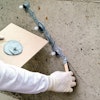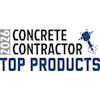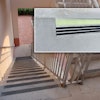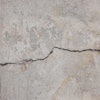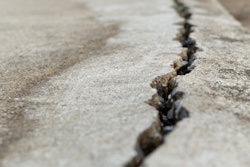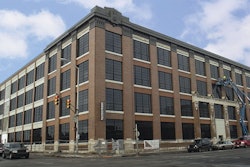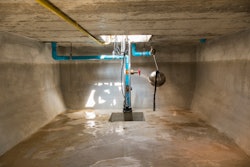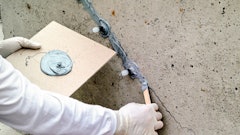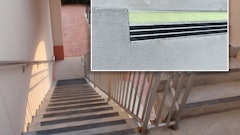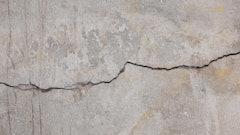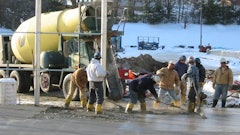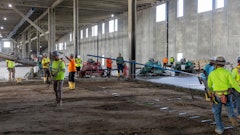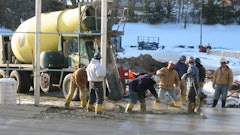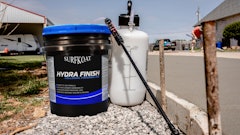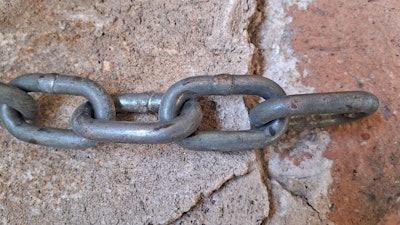
There are many ways to evaluate concrete in-place, from visual inspection to physical test methods in cases of concrete repair to full replacement. These techniques are often employed in the commercial concrete construction industry as directed, in most cases, by Licensed Design Professionals (LDPs). These same test methods of inspection and evaluation are just as valid when used to assess light commercial and residential concrete structures. After all, concrete is concrete. The purpose of these test methods is to assess the condition of concrete to inform maintenance and repair decisions.
When assessing concrete to determine if a slab may be repaired, what areas need repair, and when concrete is ruled to be removed and repoured, the investigation goes from visual inspection to testing the in-place concrete for soundness.
What is Concrete Soundness?
Concrete soundness refers to the structural integrity and durability of the hardened concrete. Specifically, we are looking for cases of surface delamination, which may have advanced to disintegration of the concrete throughout its structure. The test methods to check for concrete soundness are appropriately referred to as “sounding.”
By becoming aware of and employing these test methods, we can look beyond the default course of action, “when in doubt, tear it out.”
Delamination is a mode of failure where there has been separation of layers in a body of concrete. These layers form hollow pockets, which can go from a surface problem to extreme, where the layering continues throughout the depth of the slab.
 Example of concrete delaminationDirk Tharpe
Example of concrete delaminationDirk Tharpe
Delamination might not be as apparent as pictured above. (At this point, let us be clear. This article is not about assigning cause to delamination, but to identify areas of concrete that must be removed for repair or removal in full.) This is why it is best practice to conduct sounding tests over a slab’s surface to factor into a plan before proceeding with concrete repair.
Sounding test methods are also valid to use in issues of concrete capping or overlay bonding failure investigations. These are situations where a cementitious material that has been overlaid may have a lack of bond with the underlying concrete.
Before we go further, it is generally agreed that sounding techniques should not be used on frozen concrete.
 Example of concrete capping failure resulting in delamination.Dirk Tharpe
Example of concrete capping failure resulting in delamination.Dirk Tharpe
Types of Sounding
The simplest form of sounding is often referred to as the “chain drag” or “hammer tapping” test. As rudimentary as dragging a chain or tapping concrete surfaces with a hammer might seem, it is one of the prescribed procedures of ASTM D4580: Standard Practices for Measuring Delamination in Concrete Bridge Decks by Sounding.
The tools needed to perform the test are readily available. One needs a length of chain, a hammer, a steel rod (optional), and a temporary method of marking on the concrete surface, such as chalk or lumber crayon.
 Tools needed to conduct Chain Drag test on delaminated concrete.Dirk Tharpe
Tools needed to conduct Chain Drag test on delaminated concrete.Dirk Tharpe
To perform the “chain drag” test, simply hold one end of the chain and, using a tossing motion, let the chain fall onto the concrete. Listen for the sound of impact. Did it ring or did you hear more of a thud? If you are unsure of the sound, repeat the process several times. The ring response denotes solid concrete. A thud is indicative of hollow area.
Now drag the chain towards you in a serpentine fashion. Again, if it rings as you pull it, there is a solid surface below.
Extreme delamination will sound like you are dragging the chain across a pile of eggshells.
If the dragging sounds more like a scraping sound, then voids under the concrete surface are present. As you pull the chain, you might experience ringing, scraping, and then back to ringing. This is normal. Extreme delamination will sound like you are dragging the chain across a pile of eggshells.
Work your way around the slab, noting the areas that give off a thud or scraping sound. These are areas for further investigation of delamination and candidates for possible layered removal.
The chain dragging process is used to identify the general areas for further concentration. However, be careful to differentiate between the sound of delaminations and changes in slab thickness. This technique is most effective in identifying delaminations within 2 to 3 in. of the concrete surface.
The chain and hammer are used in tandem. Once the general areas of delamination have been identified, go back over them while tapping with a hammer. Hammer sounding is better at locating the exact areas of the delamination. A steel rod also works well for tapping and zeroing in on problem areas.
Looking at ASTM D4580 for guidance, we see that overall the chain, hammer, or steel rod, need to be substantial enough to produce the desired sounds. However, there is some discussion concerning the chain:
A common chain drag configuration of 4 or 5 segments of 1-in. link chain of 1/4-in. diameter steel approximately 18-in. long, attached to a 2-ft. piece of aluminum or copper tube to which a 2-3-ft. piece of tubing, for the handle, is attached to the midpoint, forming a T.
It is further noted that using heavier chains produces a more definitive sound in areas of heavy traffic.
When looking to the application of ASTM D4580 chain drag test on commercial, DOT, or as designated by a LDP, the decisions on the chain weight, etc., will be specified. Here we are bringing the spirit of the delamination test from the “spec world” to everyday use.
You will get a good result by using a heavy-duty chain from 1/4 to 5/16 in., or even 3/8 in. The handle, as described in ASTM D4580, is not necessary. You will feel the impact through the chain end in your hand. Speaking as the author, I use a 5-6-ft. length of chain for the testing.
Any hammer will suffice. But, from personal experience, I prefer a 22-28-oz. framing hammer with a metal shaft or neck for tapping. It is wise to employ a smooth face hammer for this purpose, so as not to scar the concrete surface. The steel rod can be as simple as a length of #4 rebar.
Use the chalk or other marking material to circle the areas of delamination. The identified delamination layers will need to be removed and then cleaned of debris.
Ready for repairs? Not quite.
Are you ready to proceed with applying concrete repair materials at this point? In a word, no. Use hammer sounding and/or steel rod tapping again over the newly exposed area of delaminated concrete. Even though the concrete surface looks rough, it still produces discernible sound when tapped. You may still experience hollow or crunchy sounds. Alternate removing material and using sounding techniques until the entire area rings firm.
The picture below shows an 80-plus year-old concrete step that exhibited extreme delamination. By using sounding and chipping, as the layers were peeled away, what was left was sound concrete, ready for the application of concrete repair materials.
 Concrete step with delamination removed, ready for repair.Dirk Tharpe
Concrete step with delamination removed, ready for repair.Dirk Tharpe
As mentioned previously, in worst-case scenarios, the delamination goes throughout the slab. This is a case of concrete disintegration. The concrete in question is no longer structurally stable. Concrete, in this state, will need to be completely removed and replaced.
Using the chain drag technique will also help identify areas of poor compaction or settled subgrade under hardened concrete. When letting the chain fall unto the slab, the thudding sound is like that experienced in detecting delamination, but there is more of a feel to it. The concrete sounds solid, yet it does not ring. Instead, you can feel a hollowness in the vibration following the chain drop. You can slightly feel it through your feet. Here, the concrete surface may be repaired or overlayed to give a fresher look, but the LDP and owner need to be informed of possible subgrade issues. Subgrade failure can lead to numerous effects to the in-place concrete above it over time. Concrete repair of overlay is a bandage or dressing until the budget is saved up to address the subgrade issues.
In cases where the LDP or owner wants more testing or analysis to substantiate the chain drag and hammer tapping results, some other, more complex test methods are available, at a cost.
Additional Sound Test Methods
Impact Echo — A specialized device uses stress waves to find the presence of cracks, delaminations, and other voids in concrete. This is done by registering how the sound waves travel through the concrete and echo back to the surface. Sensors are placed on the concrete surface to detect the echoes and record the results. Impact-Echo can also be used to measure the thickness of concrete slabs.
Training is required to properly use impact echo devices and correctly interpret the results. Contact local concrete testing agencies in your area to find and contract a qualified technician to perform this test.
Impulse Response Testing — This testing involves excitation of surface concrete with a calibrated hammer and measurement of the structural response with a transducer. As expected, areas of delaminated concrete will respond differently from areas of sound concrete. As with the Impact Echo testing, significant training is necessary to operate the equipment and interpret the results.
Infrared Thermography (IRT) — Infrared thermography is a useful method for detecting defects in concrete structures, such as delaminations, cracks, and voids. This test works by detecting differences in the flow of heat through a slab, which is then visualized as thermal images.
For this to work, the slab needs to be heated by direct exposure to sunlight. Heat flows more slowly through voids and delaminations (air) than through solid concrete. These changes in heat flow cause localized differences in surface temperature. By measuring the surface temperature while the slab is heating up or cooling down, the location of delaminations can be determined. Again, specific training is required to perform this test method.
Applying Sound Tests to Your Project
All the test methods covered in this article are considered a non-destructive test (NDT), meaning they do not physically impact the in-place concrete, nor the concrete surface being evaluated
Of the test methods discussed, the “Chain Drag” method is the easiest to master and adds no real cost to a concrete project. All you need to do is get a chain and a hammer and go practice on some concrete.
Consider using these concrete exploratory test methods on your next concrete in question. Doing so provides you a more informed decision as to whether to repair the concrete or tearing it out and repouring. It can make the difference to the owner in being able to afford the repair needed, get more life out of the concrete in-place, as well as keeping some concrete debris out of the landfill.
If you want to learn more about the vast world of concrete repair, contact the International Concrete Repair Institute and consider becoming Concrete Surface Repair Technician (CSRT) certified.
When in doubt, sound it out!

